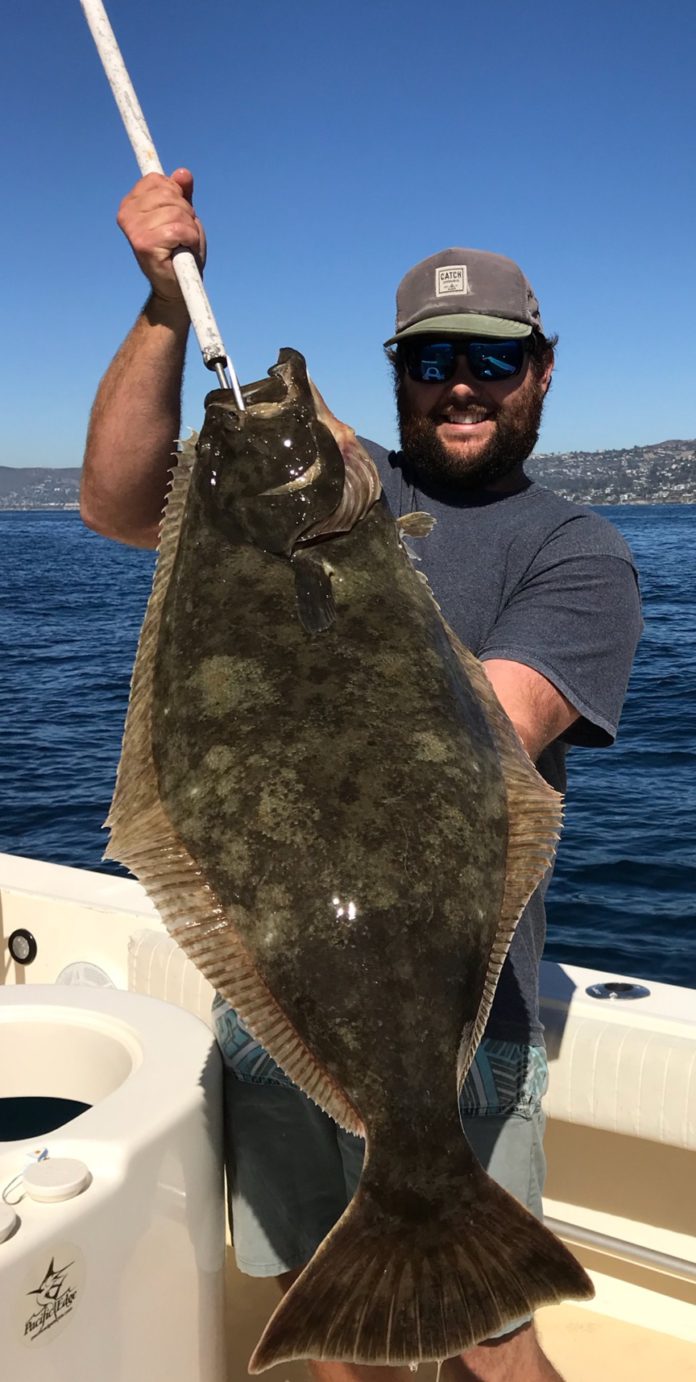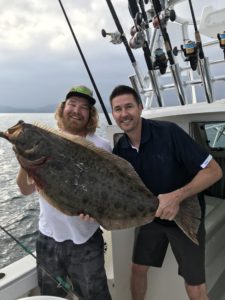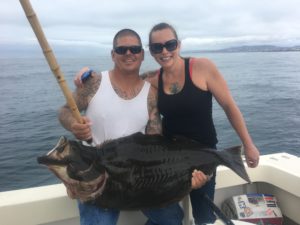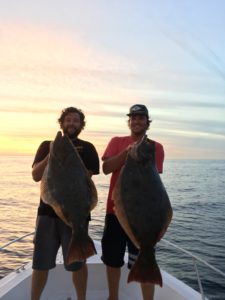
BY DANIEL LABARBERA
This year’s Big Fish Challenge has a payout as big as ever, with a grand prize package up for grabs in each of the five categories valued at almost five thousand dollars. Species include white seabass, yellowtail, bonito/barracuda (as one), lingcod, and halibut. Starting in July and running through September 9. Most will be after the usual summer catches, while halibut take a back seat for most in the southern areas. Being less competitive, weekly winners aren’t always crowned for these bottom feeding game fish. This leaves a lot of play for anglers who choose to target them for their chances to win.
Halibut in the summer don’t get the attention as they do in the spring and fall months especially down south. The bait isn’t always balled up on the beach and targeting flats fish under them is less productive. Plenty of these fish move shallow to spawn near the surf in spring, and some will stay throughout the summer months. Others will venture back out to deeper haunts and relate to various structures including high relief reefs, wrecks, coble, and kelp lines. These fish won’t always be on the structure but will be near it, in the sand or mud waiting in ambush.

Current has a lot to do with fish positioning on these structures, bites come and a pattern follows. Understanding how water flows around them creating eddied whirlpools of food accumulating dinner plates can mean the difference between bites and bust. Halibut are an ambush hunters and what better place to do this than the spot where all the dying, injured, or feeding bait congregate. Interpreting this pattern is usually done by simple trial and error, the scientific method you learned back in grade school comes back into play.
First thing Is observation. Simply looking around at what you can see happening on the water’s surface. Current direction in this case is what you’re trying to decipher. Water swirling behind a buoy on the way to your spot, kelp stringers laid down, or even the direction a boat is anchored nearby.
Watch the fathometer as you crisscross over the spots. Take note on what side of the structure the perch are stacked up on. From there you can hypothesize what side of the structure you think the halibut may be relating.
Drift the zones you feel have the best chances at getting a bite and draw your conclusion on the results. Sometimes the halibut are on the side of the structure where all the bait is, other times they’re not. Every day is a little different, but most spots in similar depths will fish the same. So if you get bit on the leeward side of hardbottom in forty foot of water good chance that behind the next stone in a similar depth you’ll have similar results. “Raked” baits are a tell tail sign that your offering was in front of a flat fish. When bites aren’t happening switch the structure your fishing. This kind of halibut fishing is not your typical long drift over big flats or bounce balling around schools of bait. This is target fishing, where finding the spot on the spot to get bit makes the difference. Drifts are short maybe only one hundred feet off the spots.

Targeting halibut while on the anchor can be effective as well. Backed into a kelp line or hard bottom, fishing a light dropper loop with a half to one and a half ounce torpedo will allow the bait to hit bottom, but move with the current back to the structure. Again actively fishing you’ll want cast the rig with a live bait from the stern up toward the bow at an angle away from the boat. With rod in hand, allow the current to move the bait back to the stern covering water. Keep the line as tight as possible without puling it in closer, as it passes your position you will be able to let slack out and the bait will continue its drift. Finally with the rig off the stern toward the structure you will have hopefully caught something, whether it a bass or the targeted halibut. Winding in and resetting the drift by making another cast the process start over again. A fresh lively bait isn’t always needed for this, two to three “drift casts” and even a bait with some bass rash will get bit. Setting the scene of injured bait drifting in the current along the bottom, the meal is almost always too easy for a large halibut to pass up.

Rigs are pretty standard for this type of fishing. Depending on depth a dropper loop, reverse dropper, or even Carolina come into play. Shallow water less that 60 foot you can usually get away with the reverse or Carolina rigs, while in deeper water up to 200 foot a standard dropper loop is preferred. During this type of fishing in shallow water try and get away with the lightest possible rig. On the deeper end of the spectrum it is usually heavy as you can handle. Rockfish style one pound cannon balls aren’t uncommon when you want a vertical presentation for a solid connection between bait and angler. A circle hook or offset Mustad like a 92677 are a favorite, but fish what you’re confident in. Trap rigs aren’t necessary and sometimes cause more problems than success. If you’re getting tail bit try pining your bait there. You’re not fishing long drifts so a lively bait tail hooked isn’t a problem.
Tackle wise, a seven to eight foot rod rated from 15-30 with a moderate action works great. An 870 style rod comes to mind first with reel to match and line of choice. While fishing shallow less than 60-foot you can’t go wrong with 20-pound test monofilament. In deeper waters things get different. With line stretch and line drag becoming a factor, super lines and medium length top-shots of heavier mono come into play. Keep things simple and don’t overthink the gear you use.
Bait again is simple. Sardine, anchovy and mackerel are first that come to mind with more exotic baits being top smelt, squid and anything you can jig up around the structure. Big halibut eat perch just some food for thought.
The take away here is that if you haven’t already looked into the outstanding value that is the Big Fish Challenge, or if you are already planning to fish it; don’t overlook the bottom grabber options during this summer long event. Often overlooked halibut support a year round fishery in southern California waters.



